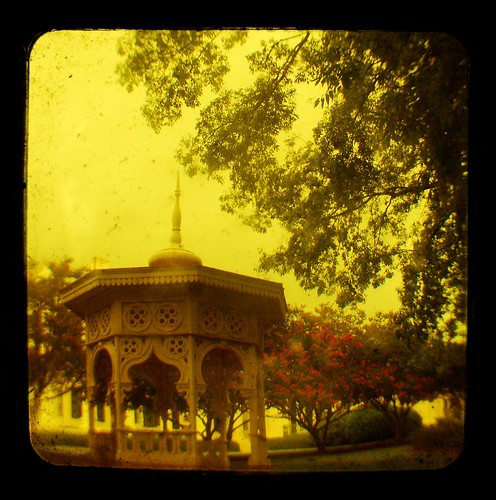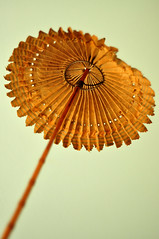My latest antiques buy was an eBay find, it was so unusual I had to bid on it, unsure if it was a parasol, as the seller thought, or if it was a hand held fire screen, similar to some ivory-handled examples I had seen about a year ago.
When it arrived, though, it became pretty clear that a fire-screen this was not. It's a parasol for sure. But it was very much unlike any other example I had seen.
Plus, it had a patent date on it. And that got me started on my research.
Innovation was a Victorian specialty. Nineteeenth century philanthropists, home-spun and ivy-league educated, believed it could bring about social reform. Those whose aspirations were less high-minded pursued innovation to seek fortune, or to make life more convenient.
The inventor as a hero reached its peak during the nineteenth century. While it was Alexander Graham Bell and Thomas Edison who have become today’s household names of nineteenth century innovators, the everyday man was getting into the act as well.
The result of this is hundreds of thousands, if not millions of patents for every kind of object, apparatus and gadget. Most of these patents were placed in archives, and today are searchable online. This made things really easy for me.
The patent date on the turned, lightly colored wooden handle, was December 24th, 1867. A couple internet inquiries matched this date to a patent issued to a Cornelius St. John of Charlestown, Massachusetts.
Cornelius St. John has a number of patents on file. Not including the patent that he was issued for the design of this parasol, he was issued a patent for a lamp (Pat. No. 72242, Nov. 19th, 1867), a lamp burner (Pat. No. 75483, March 10th, 1868), and most unusually a device for self-teaching of the Harmonica (Pat No. 176124, 1876). By 1876, St. John had moved from Charlestown and had settled in Boston.
St. John appears to have been involved in some part with oil lamps during the late 1860s, as both patents for the lamp and lamp burner of 1867 and 1868 respectively indicate, as does his patent for the Improvement in Parasols (Pat. No. 72695) which indicates that the design of the folded canopy of the parasol is not unlike the paper lamp shades of a lamp. I’ve not yet been able to conclusively say what exactly St. John’s profession was at the end of the 1860s.
As the patent shows, the diminutive sunshade is opened by a metal ring which slides up and spreads the pleated canopy. This same ring holds the canopy closed when not in use. The canopy is a polished cotton material. I was surprised to find that the canopy was lined also with polished cotton. The outside is a brown and steel-blue, but looking in between the tight pleats toward the top of the canopy indicates that these stripes were originally azuline blue, of the extremely vivid, aniline dye variety.
So, it’s kind of neat. And in an odd coincidence, I was packing up the packing material leftover after I had unwrapped it, and noticed the return address. It came from Cold Spring, New York, where I spent a week in December of 2008 with a photographer friend of mine, and it came from the antique shop that my friend Jen and I went into one of the days on my visit, owned by an antique dealer who Jen took this portrait of. It put a smile on my face. I’m happy I helped support Cold Spring’s economy. Because I like Cold Spring.
Tuesday, January 19, 2010
Thursday, January 7, 2010
Overlook(ed)
I was shocked today when I was going through my archives and found that I hadn't posted this particular shot I had taken back when I went to Decatur Alabama back in September of 2008*. On the return leg of the trip, we stopped in Macon, Georgia. There, I found this large antebellum house named Overlook, sitting atop the hill. Standing on its wide verandah, it's not at all doubtful as to how the house got its name, as the view of the city from it is pretty impressive.
 That was what was really wonderful about going to Macon, is being surprised. I was surprised that the summerhouse was still there - because normally these things go away. Really fast. Such is the nature of most nineteenth-century garden structures: they don't have a good survival rate.
That was what was really wonderful about going to Macon, is being surprised. I was surprised that the summerhouse was still there - because normally these things go away. Really fast. Such is the nature of most nineteenth-century garden structures: they don't have a good survival rate.
But what this post is about - to bring it to a quick wrap-up, is that I am surprised this house, and its grounds don't get more attention than they do. Overlook has to be the finest, and largest of the antebellum houses surviving in Georgia. If it's not the largest, or finest, then it is among those largest and finest that do survive in Georgia, and the South in general. Yet there is very little about it online, or in print that I am aware of.
Overlook no longer should be overlooked. It deserves to be done justice by its loveliness.
* Even I was a bit guilty of not giving it its proper due - because it took me nearly two years to realize I had never posted a photo of the house. Which is a bit bad because I really like this (and by this photo, I refer to the one at the top of the blog post) shot of it. I used to be really into the yellow filter (not a photoshop filter, but the actual screw-onto-the lens filter that photoshop can never match the effect of) and this trip fell in the peak of my yellow-filter addiction. It has since waned drastically, but I still take it out and use it on occaasion, and I still like it.
I had known about the house before, finding it (or, rather, its saracenic summer house) in John Maass's book The Victorian Home in America, the 1972 follow-up to his 1957 volume The Gingerbread Age: A Victorian View of America. (Maass's 1957 book is notable as being one of the first positive overviews of American nineteenth-century architecture and culture, after a half-century of retrospectives which had presented the American Victorian period in negative, scornful light.)
I was pleased, after some frustrating research (the building was renamed "Woodruff House" after it housed a private school/university in the 1960s and is listed on the National Register of Historic Places as such. This made researching the house as "Overlook" somewhat difficult.) to find that the house was still standing on its tall hill in central Georgia - but it was the summer house, with its wonderfully sinuous saracenic lines that I was concerned about the most. It was really special.
 That was what was really wonderful about going to Macon, is being surprised. I was surprised that the summerhouse was still there - because normally these things go away. Really fast. Such is the nature of most nineteenth-century garden structures: they don't have a good survival rate.
That was what was really wonderful about going to Macon, is being surprised. I was surprised that the summerhouse was still there - because normally these things go away. Really fast. Such is the nature of most nineteenth-century garden structures: they don't have a good survival rate.But what this post is about - to bring it to a quick wrap-up, is that I am surprised this house, and its grounds don't get more attention than they do. Overlook has to be the finest, and largest of the antebellum houses surviving in Georgia. If it's not the largest, or finest, then it is among those largest and finest that do survive in Georgia, and the South in general. Yet there is very little about it online, or in print that I am aware of.
Overlook no longer should be overlooked. It deserves to be done justice by its loveliness.
* Even I was a bit guilty of not giving it its proper due - because it took me nearly two years to realize I had never posted a photo of the house. Which is a bit bad because I really like this (and by this photo, I refer to the one at the top of the blog post) shot of it. I used to be really into the yellow filter (not a photoshop filter, but the actual screw-onto-the lens filter that photoshop can never match the effect of) and this trip fell in the peak of my yellow-filter addiction. It has since waned drastically, but I still take it out and use it on occaasion, and I still like it.
Wednesday, January 6, 2010
And, I resurface
I finally resurface after a couple weeks of hiatus, but I had not abandoned this blog again! No, my hard drive on my laptop had died, so I was working off a surrogate for a few weeks - but things are back up and running and I have a posse of posts on the way over the next week or three. So, those who read this (although why I'm singling y'all out as those who don't read this probably don't even know of this blog) watch this space for more posts.
And my duh-of-the-day moment: I realized I had the title of this blog spelled wrong. There is no "tit" in "decrepitude" unless you're talking about old-lady boobs. Apologies for that joke - and the mental image created (gah!)
So if anybody noticed the misspelling, I'm really NOT an idiot, really I'm not.
And my duh-of-the-day moment: I realized I had the title of this blog spelled wrong. There is no "tit" in "decrepitude" unless you're talking about old-lady boobs. Apologies for that joke - and the mental image created (gah!)
So if anybody noticed the misspelling, I'm really NOT an idiot, really I'm not.
Subscribe to:
Posts (Atom)

